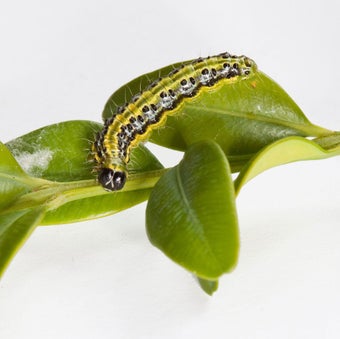
Quick facts
Common name - Small ermine moths
Scientific name - Yponomeuta spp
Plants affected - Hawthorn (Crataegus), apple, Sedum, bird cherry (Prunus padus), Prunus spp, Euonymus
Main symptoms - Defoliation and webbing
Most active - April to July
What are small ermine moths?
Small ermine moth adults have white wings with black markings, they have a wingspan of approximately 20 mm and belong to the family Yponomeutidae. The creamy white, black marked larvae reach 20 mm in length and feed gregariously under the cover of a dense silk webbing. They are difficult to identify as adults but each has a different host range. There are several species that are often found in gardens, these include:
- The common small ermine, Yponomeuta padella. Found on hawthorn, blackthorn and wild cherry, but not bird cherry (Prunus padus)
- Bird cherry small ermine, Y. evonymella. Found on bird cherry, Prunus padus. This species can cause complete defoliation and spectacular webbing during the later spring and early summer
- Euonymus small ermines, Y. cagnagella and Y. plumbella. Found on Euonymus
- Willow small ermine Y. rorrella. Found on willow, Salix
- Sedum small ermine Y. sedella. Found on Sedum
- Apple ermine Y. malinellus. Found on ornamental and fruiting apple

Symptoms
Most small ermine moths emerge as adults in July or August, and soon mate and lay eggs. Larvae hatch from late August and overwinter whilst still small. They begin feeding again in spring and are fully grown by June. They can cause extensive defoliation - this and the silk webbing produced whilst feeding can cause alarm. Plants however, often recover from any damage. The caterpillars pupate within the webbing.
The sedum small ermine can have two generations a year with active caterpillars in June-July and September-October.
These caterpillars should not be confused with the webbing caused by box tree caterpillar, cotoneaster webbers, brown tail moth or oak processionary moth.
Management
Defoliation is most severe on small trees and plants and the webbing can cause alarm, however, it should not affect the long term health or vigour of host plants and where possible can be tolerated.
- Where possible tolerate populations of these caterpillars, as butterflies and moths are an important part of the garden ecosystem and damage to plants is usually only short term
- Encourage predators and other natural enemies in the garden such as birds, hedgehogs and ground beetles
- Check plants regularly from spring for the presence of larvae and remove by hand where practical. The gregarious nature of these caterpillars means it is sometimes possible prune out affected shoots















